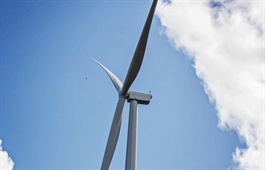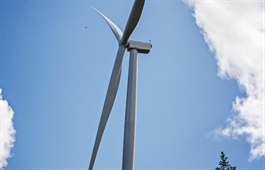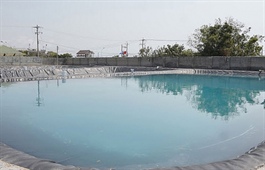Adjusting to new energy methods in Ninh Thuan
Adjusting to new energy methods in Ninh Thuan

Adjusting to new energy methods in Ninh Thuan
|
Over the last few years, renewable energy has blossomed in the south-central province of Ninh Thuan, with wind turbines and solar rooftop panels found in nearly every locality. Energy has since become somewhat of a keyword in the province in addition to the sunshine, wind, and the poor-quality soil mixed with sand that usually dominates Ninh Thuan’s landscapes.
Along with the physical development, the lives of many local people have been enhanced in the wake of the emergence of these modern energy models.
Talking to VIR in his hometown of Phuoc Minh commune in Thuan Nam district, grocer Tran Van Sang said he received almost VND2 billion ($87,000) in compensation last year in return for over three hectares of agricultural land. The amount has since been spent on building a new two-storey house along with some modern equipment and even new bikes for all family members.
“Instead of feeding some cows or cultivating some plants, which could not generate enough money for us to improve our lives, we have received all this money which has enabled most of our dreams to come true. Now, I only run this shop to earn money for everyday expenses,” Sang said.
Across other roads, there are numerous newly-built houses with tall gates standing before huge mountains, and newly-bared plots of land which have already been handed over to investors. Pham Viet Khac, head of Quan The 1 Village, told VIR the land compensation price for renewable energy projects is currently around VND140-800 million ($6,000-35,000) per hectare in this province – a price which has been rising as each year goes by.
“In the 2000s we were paid only VND800,000 per hectare for a salt project from the local government. My house was the most beautiful in the village, but now it is mediocre compared to the newly-built ones thanks to renewable energy projects,” said Khac.
According to Ninh Thuan People’s Committee, as of the start of February around 37 solar power projects have been granted investment certificates at a total capacity of 2,576MW, including 32 projects put into commercial use; while 15 wind power projects have been granted certificates with a total capacity of over 766MW, including three for commercial use.
Centre of renewable energy
Amid the rapid development of the economy, demand for energy has inevitably been on the increase. While primary energy sources like coal, oil, and gas are limited, renewable energy is considered a suitable solution for Vietnam and every country to fill the lack of energy.
In this country, Ninh Thuan is the locality with the lowest annual rainfall in the country, while sunshine and wind are plentiful enough to develop renewable energy.
The total sunshine time is around 2,600-2,800 hours in the province every year, equal to 200 sunny days. The average total heat radiation is also high at 5.2kWh per square metre, higher than in both northern provinces (4kWh per sq.m) and southern provinces (5kWh per sq.m). Meanwhile, wind speed there is also fastest across the country at 7.5m per second on average, while the country’s average of wind speed is six metres per second only.
“Utilising the advantages of natural conditions, Ninh Thuan has planned to become the centre of renewable energy for the country, enabling this industry to become a major economic sector and a driving force for the breakthrough and socioeconomic development of the province,” said Ninh Thuan People’s Committee Chairman Tran Quoc Nam.
He confirmed that the potential of developing renewables and mobilising investment into the province in the draft of the coastal wind power development plan in Ninh Thuan during 2021-2030, with vision to 2045, and solar power plan in the 2016-2020 period, with vision towards 2030, submitted to the Ministry of Industry and Trade in January.
At present, five locations on an area of over 21,400ha are in the plan for wind energy with the total capacity of 1,429MW or 2,000MW (if equipped with the most cutting-edge technologies), while total capacity may be 4,380MW by 2045. And total capacity of solar power could rise to around 8,180MW by 2030.
“Renewable energy has been contributing remarkably to the economic restructure of the province, raising industrial production and especially enabling Ninh Thuan to be in the top five highest-growth localities over the last five years,” Nam said, highlighting the contribution of renewable energy.
Behind the evolution
In addition to practical benefits that renewable energy generates to improve transport infrastructure, use huge areas of wasteland, and reduce greenhouse gas emissions, the speedy and alluring development of renewable energy projects has nevertheless raised some concerns among the people who know the local environment best.
Clearing all plants and weeds on mountains and other land creates bare hills that facilitate dangerous rainfall. In last November, heavy rains over a few days flooded around 1,000 houses in Ninh Thuan and destroyed 500ha of rice and other plants in districts such as Thuan Bac, Ninh Hai, Thuan Nam, and Bac Ai.
“My house, even next to the National Highway No.1, was immersed in almost a metre of floodwater,” said Khac at Quan The 1 Village. “I have lived here for more than 70 years and have never seen such an incident like this.”
Nguyen Ngoc Huy, an expert from non-governmental organisation Oxfam, explained that millions of solar panels in Ninh Thuan are tilted in the same direction, causing flow concentration. “The sewer system is quite narrow and investors may not pay enough attention to the drainage system. Flow concentration can make a small flood in the province even through only light rain,” said Huy.
Last October one of Vietnam’s biggest renewable energy developers, Trung Nam Group, launched the largest solar farm in Southeast Asia in Thuan Nam district, after only three months of construction and installing 1.4 million panels. Additionally, the construction of these solar farms has caused issues for locals in the form of spoiled roads, broken sewerage systems, and noise and dust pollution.
“The investor promised to rebuild or fix the road but they have yet to do so,” said one local resident living next to the project. “I have filed a lawsuit to local government but there was no response. It has been five months since the solar farm was put into operation, yet we still live here with broken sewers and damaged roads.”
Before the Trung Nam project, BIM Energy in partnership with the Philippines’ AC Energy and France’s Bouygues Energies & Services also launched one of Southeast Asia’s largest solar farms in mid-2019 with a total capacity of 300-330MW in Thuan Nam district.
Dozens of solar farms covering areas of around 100ha are already deployed in the province, including Re Sun Seap farm in Ninh Son district, Trung Nam Group in Thuan Bac district, Singapore’s Sinenergy in Ninh Phuoc district, and Vietnam Electrical Equipment JSC alongside Gelex in Thuan Nam district.


























